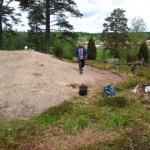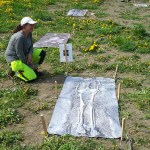As I've written before in a number of venues (e.g. Fornvännen and Antiquity), the current Swedish metal detector legislation needs to be changed. It is too restrictive in relation to honest amateur detectorists. It is keeping them from a) making valuable contributions to archaeological research, b) saving finds for scholarship that are slowly turning to a green verdigris powder in the country's ploughsoil, c) engaging constructively with their cultural heritage. We are decades behind the Danes on this. Metal detectors should be dealt with like hunting rifles: if a citizen passes a knowledge…


Aardvarchaeology
Dr. Martin Rundkvist is a Swedish archaeologist, journal editor, public speaker, chairman of the Swedish Skeptics Society, atheist, lefty liberal, board gamer, bookworm, and father of two.
In March of 2011, the Swedish government launched a state commission under County Governor Eva Eriksson to evaluate our legislation and national goals regarding the cultural environment. Yesterday the commission delivered its report, in which a number of interesting suggestions are made for changes to the body of law that governs Swedish archaeology.
The current law contains a definition of the protected archaeological site that has never been enforced to the letter. First it says that any remains that bear witness to how people lived in the past and are permanently abandoned enjoy protection…
This has me excited! The Board of the Swedish Skeptics just decided on a date and a city for the 14th European Skeptics Conference: 23-25 August 2013, Stockholm, Sweden. Check it out!
The Swedish Skeptics Association (Föreningen Vetenskap och Folkbildning) invites skeptics worldwide, and particularly in Europe, to the 14th European Skeptics Conference, 23-25 August 2013, in Stockholm, Sweden. (No, not 2012, when it would interfere with the Mayan apocalypse.) The conference is one in the series supported by the European Council of Skeptical Organisations.
The organisers wish to hear ASAP from…
Spent the day digging with my friends Mattias Pettersson and Roger Wikell like so many times before. I like to join them on their sites for a day every now and then (2007, 2008, 2010). The two are mainly known as Mesolithic scholars, but I have been with them on a Neolithic and a Bronze Age site as well on previous occasions. And this time they're straight up my own alley of research: they're digging the largest of the Viking Period burial mounds in Tyresta hamlet's southern cemetery. Measuring eleven meters in diameter and about one-and-a-half in height, it's a pretty imposing structure…
Here's a novel way to present a cemetery excavation to visitors.
At Broby in Täby, one of the world's most runestone-rich spots, is the 11th century inhumation cemetery of the famous Iarlabanki family. My colleague Lars Andersson of Stockholm County Museum's archaeology service has been excavating it bit by bit for years. Many graves are exquisitely preserved. After finishing each piece of the site he covers it again with the original ploughsoil, leaving no visible trace of his interventions. How do you present such a site to the many visitors? (Täby is an affluent suburb of Stockholm.)
Lars…
Yet another case of that silly and damaging humanities idealism.
Last month the Daily Beast listed archaeology among the thirteen most useless major subjects at US colleges, as measured by employment opportunities and earnings potential. Bradley T. Lepper, curator of archaeology at the Ohio Historical Society, objects. He argues that archaeological knowledge is valuable to the long-term sustainability of a civilisation, and so the subject should be more highly valued. Whether true or not, this is beside the point. Daily Beast didn't list subjects that they think should by rights be poorly…
Blogging from a plane over Germany! Whee! A Boeing 737-800 Berlin-Stockholm operated by Norwegian. My 1st experience with internet on a plane.
I'm at the Sixth World Skeptics Conference in Berlin, co-organised by the German GWUP and the US CSI. These conferences have been going on biannually since the mid-90s with a recent hiatus. It's the first time I'm at a skeptical event in Continental Europe. With only 300 seats it's not quite as planet-spanning as its name suggests, but it's a good crowd anyway. Some impressions:
I prefer to be a speaker at conferences.
I'm doing some intensive networking for the Swedish Skeptics who sent me here.
Also talent scouting for the European meeting we're organising next year.
It's good to hear…
Now this is how you sell pens!
The squaw had disappeared into the thick under growth, leaving a track Queen Elizabeth I 2010 Mont Blanc Limited Edition White Rollerball like a hippo in the snow. Bud could have overtaken her, of course, and he could have made her take the baby back again. But he could not face the thought of it. He made no move at all toward pursuit, but instead he turned his face toward mont blanc boheme bleu Alpine, with some vague intention of turning the baby over to the hotel woman montblanc hemingway there and getting the authorities to hunt up its parents. It was plain…
ScienceBlogs was handed over to National Geographic long ago. Behind the scenes, work has progressed to migrate the site from Moveable Type to Wordpress and put NG's yellow-margins branding onto everything. And now the switch-over is imminent. Late May maybe? The new site is already up on an interim URL. I am now copying the past few weeks' entries after the migration team copied the database for automatic transferral. Everything looks good except that I haven't figured out the Scandinavian diacritic characters yet. Any shakiness and flakiness in the near future will no doubt be due to the…
Bizarre musical development. The drum and base genre of music was created when people turned up the tempo on drum machines to insane speeds. But this guy plays drum and base beats live! Ree-spect!
Current Archaeology #266 (May) has a big feature on the Medieval and Renaissance version of Saint Paul's cathedral in London. The current one designed by Christopher Wren, I learned, re-uses none of the earlier edifice's fabric and is not even orientated on the same axis. It was the world's first purpose-built Protestant cathedral, completed in 1710. What happened to the old cathedral? Well, first the Reformation, then a century of neglect while only the chancel remained consecrated, and then in 1666 the Great Fire of London. Finally Wren's building crew tore down whatever was left.
Then a…
I'm a month from my 20th anniversary as a professional archaeologist and I'm considering my options. Unlike most people who make a living in my trade I have not worked much in contract archaeology and I have spent only a few months on the dole. Instead my main source of income during these two decades has been research grants from private foundations. Not big ones, but many of them. With a frugal lifestyle and no departmental overhead, I have produced more publications per krona than most. This has increased my chances of finding renewed funding. Publish or Perish has been my rule. Secondary…
I was thinking about African American culture and how it still shows signs of these people descending from slaves, US slavery having been abolished less than 150 years ago. And I asked myself, what is that subculture going to be like a few hundred years in the future? Then it hit me. That's where my subculture is now.
I've made the point before that all my readers are descendants of royalty. But a far greater percentage of our pedigrees lies with the slaves. All currently living members of the various European ethnic groups have ample slave ancestry.
Slavery was common in Iron Age Scandinavia…
Here's an extremely useful resource. The Swedish National Heritage Board has scanned the great multivolume corpus publication of Swedish runic inscriptions, Sveriges runinskrifter, and put it on-line for free. Currently as PDF files, but in the future there will also be a structured database. Though the PDF:s have been run through optical character recognition, they don't seem to have been indexed on Google (yet?).
For an example, read about (p. 547 ff) Kalv's runestone U 875 at Focksta in Hagby, Uppland, shown above.
My buddy Claes Pettersson is a field archaeologist in Jönköping and always has a lot of fun projects going. Last year he told me about an undocumented manor park he had studied through geophysics. Right now he's digging bits of Jönköping's obliterated castle. And recently he sent me an intriguing little fieldwork report (available on-line for free). It's a piece of, not exactly battlefield archaeology, but campaign archaeology, which is rare.
The back story is short and nasty. Sweden fought the Northern Seven Years' War from 1563 to 1570 against Denmark-Norway, Lübeck and the Polish-…
Rode a pretty rare/air plane Bromma - Kallinge on Friday morning. It was a Saab 2000, a 1992 Swedish turboprop model of which only 63 where ever built. (Apparently they saw daylight in the mistaken hope that customers would want a turboprop this size, rather than the ubiquitous jets, and lost Saab a lot of money.) This one belongs to Golden Air. On the way back I rode one of those paunchy ATR 72-500s. Both models have their cargo bays right behind the cockpit.
Sigh. Another crappy publishing deal. This firm wants me to write a 500-word encyclopaedia entry and assign copyright entirely to them, with the right to re-edit in the future. And what do they offer in return?
A £30 book coupon and access to a paywall website.
I just can't see why I would find this offer at all attractive. I don't need the book coupon or the key to that paywall. (Indeed, the paywall thing is simply like getting a copy of a book you contribute to, only much cheaper for them.) It wouldn't improve my CV noticeably to publish 500 words under this firm's imprint or under the…
The Swedish Skeptics have received the 2012 Harry Martinson Memorial Prize from his birth municipality Olofström and the Harry Martinson Society. Martinson, a Nobel laureate, was a poet and prose writer who is particularly well known for his book-length science fiction epic poem Aniara. As chairman of the Swedish Skeptics I was invited down to Blekinge province where I spent Friday looking at archaelogy and doing some metal detecting with my colleague Mikael Henriksson from the County Museum -- and on Saturday morning I delivered an acceptance speech and a talk (in Swedish) on Martinson's…

